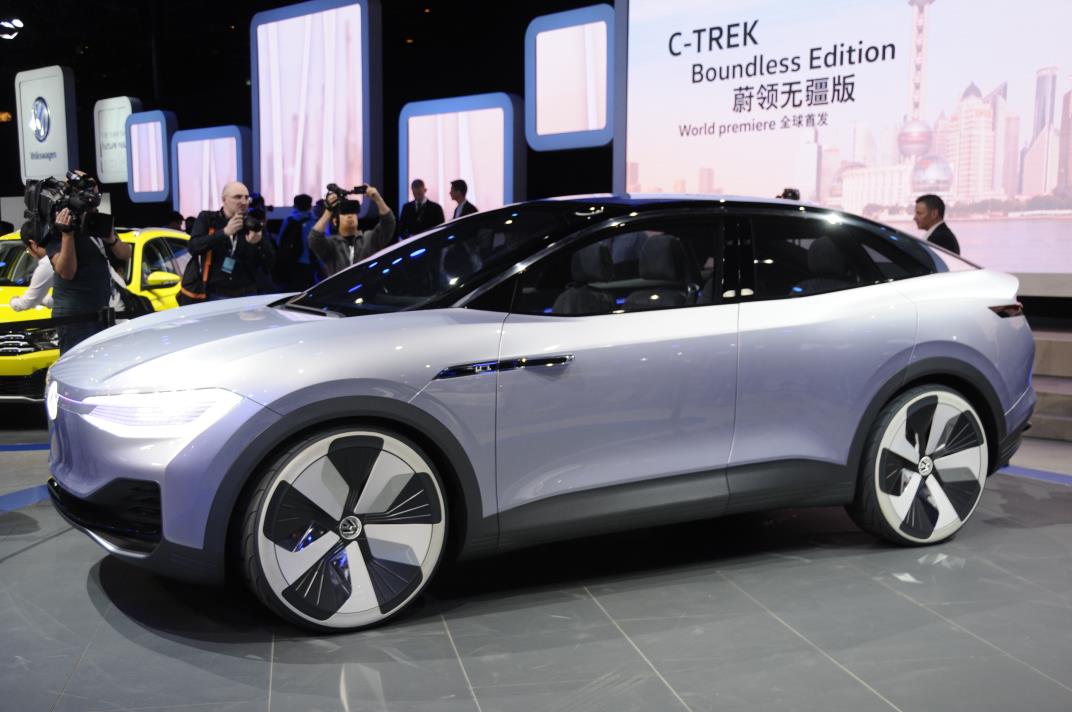
The third concept based off the new MEB electric vehicle architecture is a spacious crossover utility vehicle
- The I.D. CROZZ is a key pillar of the new I.D. family based on the Modular Electric Drive Matrix (MEB)
- The I.D. CROZZ delivers 302 horsepower, has a top speed of 112 mph and has a range of 311 miles on the New European Driving Cycle.
- The battery of the I.D. CROZZ can be charged to 80 percent in just 30 minutes (with a 150 kW DC fast charger).
- The I.D. CROZZ provides a similar amount of interior space as the all-new 2018 Tiguan
- Cockpit has augmented reality head-up display, Active Info Display, infotainment tablet and door panel controls
- In ‘I.D. Pilot’ mode the I.D. CROZZ drives autonomously
Wolfsburg/Shanghai, April 2017. Volkswagen is developing a new fleet of electric vehicles that will start full production in 2020. At the ‘Auto Shanghai 2017’ international show, Volkswagen will reveal the I.D. CROZZ, its first electrically powered crossover utility vehicle (CUV)—a four-door coupe and sport utility vehicle (SUV) in one. Following the headline-grabbing world debuts of the I.D. in Paris in 2016 and I.D. BUZZ in Detroit in 2017, this is the third version of the I.D. family. It is also a zero-emissions vehicle with a very long range, charismatic design and a completely new interior concept. The I.D. CROZZ now underlines just how diverse the range of future Volkswagen electric models is going to be.
The I.D. CROZZ is a sporty, zero-emission all-rounder—with electric all-wheel drive—that is equally impressive in the urban jungle as it is on rough terrain. The I.D. CROZZ has 302 horsepower, a top speed of 112 mph and can cover up to 311 miles (NEDC) on one battery charge. Using a 150 kW (DC) fast charger, the high-performance battery can be 80 percent recharged within 30 minutes.
The I.D. CROZZ is more compact and has a lower roofline than the all-new 2018 Tiguan, yet the CUV provides just as much space. The key to this is the car’s design: like the I.D. and I.D. BUZZ, the I.D. CROZZ is also based on the newly conceived Modular Electric Drive Matrix (MEB). The MEB models have a very long wheelbase, with compact powertrain components and a battery that lives under the floor. The interior space is generously proportioned and provides a true ‘Open Space’.
DESIGN
The MEB’s dynamic proportions provide an ideal platform for a carefully considered electric mobility design DNA. Klaus Bischoff, Head of Design for the Volkswagen Brand, explains: “If it was ever possible to make a one-hundred percent certain prediction of what the future will look like, here it is. In 2017, we are showing how Volkswagen will be transforming the roadscape from 2020. For us, the three prototypes of this new generation of zero-emission vehicles—I.D., I.D. BUZZ and I.D. CROZZ—mark the start of a design and technology revolution that is going to change individual mobility and the Volkswagen brand forever.”
Volkswagen’s aim is to transfer electric drive systems from start-up niche to high-volume full production by the middle of the next decade. Herbert Diess, Chairman of the Board of Management, Volkswagen Brand says: “By 2025, we want to have sales of pure electric vehicles up to one million units a year. The I.D. CROZZ will play a key role in that. Production will start in 2020.”
The clear and powerful design of the I.D. CROZZ combines the rugged look of an SUV with the elegance of a coupe. Pronounced fenders and strongly contoured wheelarches frame a silhouette that’s similar to a sports car’s. The hood, meanwhile, is sharp cut and muscular. On top of this base is a roof that makes the car appear agile even when stationary. A fine stripe in the car’s body color borders the roof on each side. The solid roof supports, meanwhile, remain almost invisible.
Another defining design feature is the D-pillar, which tapers way back and, on the inside, meets the broad shoulder section rising gently towards the rear. The designers gave the side windows a low, elongated look; the imaginary B-pillar (formed from the door frames) and C-pillar are behind glass and effectively invisible.
If you were to take a camera drone on a 360-degree flight around the concept car, you would notice two further lines that further shape the overall design. Both lines give the I.D. CROZZ a look of great strength and also visually reduce its height. The first of these lines starts at the top edge of the hood, shooting left and right into the fenders, forming a powerful arc over the wheelarches. Near the A-pillars, the line merges into the window, and climbs towards the rear before finally encircling the rear window.
From this bird’s eye view, the second line appears much later on the side of the front fenders. It develops above the fender-mounted cameras as a sharply drawn character line. In the center of the back doors it climbs, thus forming the outer border of the powerfully shaped shoulder section.
Volkswagen’s signature electric mobility lighting is integrated into the front section, with an illuminated VW badge mounted centrally between hood and bumper. It joins up to the left and right with the interactive LED headlights via a fine, striking line of light.
A new feature is a movable light blind in the illuminated panoramic roof that creates ambient lighting both inside and on the exterior. The stylish rear and broad shoulder section look powerful, while the width of the car is also emphasized by a gloss black area across the rear section with thin LED matrix taillights and an illuminated VW badge.
With the countdown to the launch of the new zero-emissions fleet in 2020, Volkswagen is heralding in a new era in more than just an engineering sense. Volkswagen Head Designer Klaus Bischoff and his team are developing a new, expressive and unique fleet of electric mobility vehicles. Klaus Bischoff: “It is a design that shows great clarity and remains absolutely self-explanatory; a design that unifies form and function in breathtaking fashion; a design that naturally integrates our century’s digitalized world.”
LIGHTING
In this design, light becomes an interactive means of communication. It ‘interacts’ with passers-by and the driver. These lighting elements change the look of the CUV based on its operating status and the LED headlights even interactively emulate the human eye (Interactive Spotlight). The lighting scenarios are:
Parked. When the I.D. CROZZ has all its systems shut down, it looks from the front as if its ‘eyes’ are closed. When parked, all you see is a thin LED strip in the headlights.
Ready to move. If the I.D. CROZZ is ‘woken up’, it greets its driver and passengers with a 360-degree light show: first, the glass VW badges (at the front and in the rear hatch) light up in blue and white. Starting from the front logo, a fine white line develops from left to right, merging into the linear graphic of the LED headlights, with their five thin lines of light.
Fractions of a second later, the ‘eyes’ (LED dipped beam) of the I.D. CROZZ ‘open’. It is also possible to set the system so that the ‘eyes’ wink at the driver. Compared to the I.D. and I.D. BUZZ the sequences of ‘eye’ movements have been further enhanced: the ‘eyes’ can now glide to and fro on the lighting strips, making the sequences appear much more fluid and realistic. In tandem with the dipped beam, the laser roof sensors and the light blind in the roof are also switched on. At the same time, the sensor fields for opening the doors are illuminated. Finally, the linear graphic of the front section and of the light blind in the roof glow strikingly in a blend of magenta and violet. When the DRLs are activated, the I.D. is ready to start. When the electric doors are opened, the sensor fields pulsate; as soon as the car drives off, they are dimmed.
Regular driving. The LED linear graphic of the front section and roof switches to ‘Light Blue’. In parallel with this, the interior’s ambient lighting also adopts this color. As the car accelerates, the ‘eyes’ adjust to the higher speed by adopting a more dynamic light signature, becoming narrower and more concentrated.
Autonomous driving. If the driver activates the fully automatic ‘I.D. Pilot’ mode, the exterior and interior ambient lighting switches to ‘magenta/violet’. On the outside the laser scanners also deploy, lit up with a small ring of white light. The exterior ambient lighting is now no longer static, but dynamically animated. If the speed increases, the ‘eyes’ peer ahead with a sportier look. The LED headlights switch in parallel to an interactive mode: if, for example, the I.D. CROZZ wants to turn left or right, the LED headlights look in the direction that the car is going to turn. Furthermore, if the vehicle registers anyone at the edge of the carriageway, it ‘looks’ at them, making pedestrians and cyclists more aware of its presence.
INTERIOR
Around five years after the first I.D. vehicle goes on sale, from 2025, fully automated driving will trigger the next automotive revolution. The CUV concept car being unveiled in Shanghai already has this on-demand autopilot system on board. In the fully automated ‘I.D. Pilot’ mode the multifunctional steering wheel retracts into the dashboard and fuses with the digitalized instruments (Active Info Display) to form a single unit. In both automatic and manual mode the driver also receives speed and navigation information via an augmented reality head-up display.
Thanks to the compact electric drive system and to the underfloor lithium-ion battery, the interior has been transformed into an ‘Open Space’: a variable, lounge-like space offering a superior amount of room. The driver and front-seat passenger sit on high-quality seats with integrated seatbelts and headrests. Rear-seat legroom is at a premium level.
The interior of the I.D. CROZZ, with its multifunction seating concept, is highly flexible. Want to take your bike away with you for the weekend, but have no cycle rack? Simply push it sideways into the back. Large swing/sliding doors and flexible rear seating make this possible, with the seat cushions being tipped up for this purpose, like the seats in a movie theater. The passenger compartment doors also retract fully back, making loading easy. The fact that the front doors open unusually wide at a 90 degree angle and Volkswagen has simply done away with the B-pillars makes it even simpler. All doors, rear hatch and hood open electrically.
An optimum, customized in-car climate is ensured by Volkswagen’s newly developed CleanAir system, which has an active filter system to constantly ensure top air quality in the interior. The menu provides information on the quality of the air in the car (Air Quality Index) and on the system’s current activity. What’s more, it is possible via pre-saved climate conditions for the driver and front-seat passenger to activate a defined airflow, plus temperature and air humidity levels, that you might find in a pristine environment. So, for example, the I.D. CROZZ can be driven through the center of Shanghai with air quality like that in the Himalayas.
The Volkswagen User-ID, an individual profile stored in Volkswagen’s own digital eco-system that is activated via a smart device, works like a digital key. As soon as anyone nears the car with the device, the I.D. CROZZ recognizes them. The doors are then unlocked and all personal parameters, extending even to such features as climate settings, are activated.
The sculpted, flowing structures of the surfaces are inspired by nature—bionic shapes instead of cold engineering. The design, with its organically shaped surfaces and gentle radii, emphasizes the impression of space. Life on the move also becomes less complex because switches and levers are replaced with new digital solutions that lead to a new, intuitive world of operation. An animated lighting system, for instance, enables drivers to notice details even in their peripheral field of vision. If, for example, any pedestrians appear alongside or in front of the I.D. CROZZ, the driver is warned by a change of color.
The I.D. CROZZ is operated via self-explanatory touch displays, capacitive keypads, and voice and gesture control. The digital hub is formed by the electrically adjustable and retractable multifunction steering wheel, an Active Info Display, an electronic rear-view mirror (e-Mirror), the augmented reality head-up display, and a door panel.
Integrated in the middle of the instrument panel is a 10.2-inch tablet that forms the infotainment system with an individually configurable home screen. It can be individually laid out via four different function-related tiles, such as ‘Messages’, ‘Media’, ‘Telephone’ and ‘Navigation’. Housing and screen merge seamlessly into one another. A new feature here is the ‘CleanAir’ menu, which shows information on the air quality and activates preconfigured climate settings.
The steering wheel is an illuminated sensory surface with which the driver can switch from manual to fully automated (‘I.D. Pilot’) mode. This is done by touching the VW logo for three seconds. The steering wheel then retracts into a flush position within the dashpad. The traditional round shape is changed to a wheel with six rounded corners, creating a high-tech steering wheel. Integrated into the bottom section is an ‘island’ with illuminated capacitive fields that control things like: the ‘P’, ‘R’, ‘N’ and ‘D’ gears; turn signals; phone calls; playlists; and volume for the sound system.
The driver receives all data relevant to driving, such as speed and visual navigation instructions, via the head-up display. Directions, for instance, are projected as virtual images 23 to 49 feet ahead of the car. The effect is astonishingly realistic: direction arrows are projected via augmented reality to show exactly where the driver is heading and become part of the driver’s three-dimensional surroundings.
A 5.8-inch Active Info Display shows information to the driver and can also be used, just like the tablet in the instrument panel, to view standard content such as the media library or satellite navigation map. The display uses three transparent layers to display the various types of information. On the bottom, the navigation map is on the first layer; the digital content retrieved using the Volkswagen User-ID is displayed on the second layer; and the third layer, on the top, is used to display driving data such as the distance to the destination. Conventional rear-view mirrors are replaced by the e-Mirror. A monitor combines the data from three external cameras and transmits the images to the driver.
Information and controls that have previously only been available to the driver and front-seat passenger are now available to rear-seat passengers, thanks to the digital door panels. These white, partially transparent control islands are ergonomically mounted in the four door trims, where they appear to be suspended in mid-air. The door panels are used to operate the electrically actuated doors, the central locking system and the electric windows. Each passenger is also able to individually regulate their climate zone. The panels are operated via capacitive buttons and sliders.
One new feature on this vehicle is the light blind integrated into the illuminated panoramic roof. This virtual blind is opened and closed by gesture control. A carpet of light produced by LED strips then glides across the roof liner, thus brightening up the interior. The strips of light in the roof are visible from the outside, too. The gesture control system’s commands are similar to those for a traditional sliding roof: a short, sharp movement of the hand opens or closes the blind completely, while a slow gesture on the other hand moves the carpet of light seamlessly until it reaches the desired position.
The I.D. CROZZ is also able to send and receive packages, while out and about. The 18.2 cubic foot trunk acts as the post box for this new delivery service: an agent is able to locate the car by GPS and is granted temporary permission to open the trunk via an app. The owner of the I.D. CROZZ is then notified via an app or e-mail as soon as the parcel has been delivered.
TECHNICAL DETAILS
The I.D. CROZZ perfectly illustrates the adaptability of the MEB architecture: the drive system components—two motors, the high-voltage battery and the electronics that link everything together—are incorporated into the car’s overall package. This gives the designers and engineers complete freedom to change the way in which the car is designed.
The 83 kWh lithium-ion battery is housed in the CUV’s floor. This creates space and lowers the center of gravity to help handling and ensure ideal weight distribution. The two electric motors develop 302 horsepower and directly drive their respective axles. Normally, the rear wheels are driven, but as soon as additional traction is needed, an ‘electric propshaft’ distributes the power between front and rear axle in fractions of a second. The I.D. CROZZ can also be permanently driven with all-wheel drive, for instance, when going off-road or in the snow. At the back the work is done by a compact 201-hp motor, while at the front it is a 101-hp coaxial drive system.
The power electronics control the flow of high-voltage power between the motors and the battery, converting direct current (DC) stored in the battery into alternating current (AC). The on-board electronics are meanwhile supplied with 12 volts via a DC/DC converter.
Because the battery is centrally integrated within the CUV and the motors are mounted at front and back, the I.D. CROZZ has an ideal 48 percent front to 52 percent rear weight distribution. As a result, the I.D. CROZZ demonstrates handling characteristics like a Golf GTI’s. The sophisticated multi-link rear and strut-type front suspension has electronic damping, with decoupled subframes that incorporate the drive system. The suspension facilitates great handling and top levels of ride and acoustic comfort. The layout of the front axle and the overall package at the front of the car also lead to a very small turning circle of 34.5 feet (10.5 meters).
The I.D. CROZZ is 182.1 inches long, with a 109.2-inch wheelbase, and is 74.4 inches wide and 63.3 inches tall. The concept car offers similar interior space to the all-new 2018 long-wheelbase Tiguan, but is 3 inches shorter, 1.9 inches lower and 2.2 inches wider.
AUTONOMOUS DRIVING
Activating the fully automatic ‘I.D. Pilot’ mode is incredibly simple: all the driver has to do is deliberately touch the VW logo on the steering wheel for three seconds and the I.D. CROZZ assumes control. The interior ambient lighting then switches from a white light (‘Drive’) that aids concentration to a warm, relaxed ‘magenta/violet’. At the same time, the distribution of ambient lighting is extended to the rear seating area.
By this point, the CUV has long since activated its laser scanners. Four of them emerge from the roof in ‘I.D. Pilot’ mode. The cleanly styled roof sensors call attention to the fully autonomous mode by indirect lighting. The I.D. CROZZ is able to detect other road users not only by means of its laser sensors, but also with the help of ultrasonic and radar sensors, side area view cameras and a front camera.
Fully autonomous mode is deactivated by touching the Volkswagen logo on the steering wheel or by pressing the brake or accelerator pedal.
TECHNICAL DATA
| Length: | 182.1 in |
| Width: | 74.4 in |
| Height: | 63.3 in |
| Wheelbase: | 109.2 in |
| Front track | 62.7 in |
| Rear track: | 62.8 in |
| Wheels/tires: | 245/45 R 21 |
Drive system/range
| Front electric motor: | 75 kW (101 hp); 103 lb ft |
| Rear electric motor: | 150 kW (201 hp); 229 l ft |
| Total power: | 225 kW (302 hp) |
| Battery energy capacity: | 83 kWh |
| Range (EU; NEDC): | 311 miles |
| Charging power: | 150 kW (DC) |
| Charge time up to 80 percent SOC: | circa 30 minutes |
Performance
| Top speed: | 112 mph |

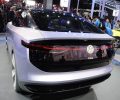
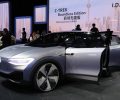
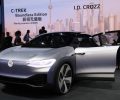
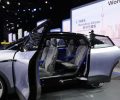
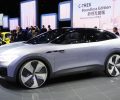
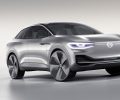
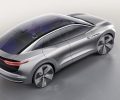
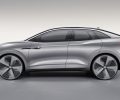
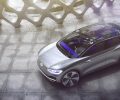
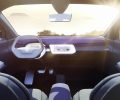
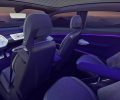
You must be logged in to post a comment.